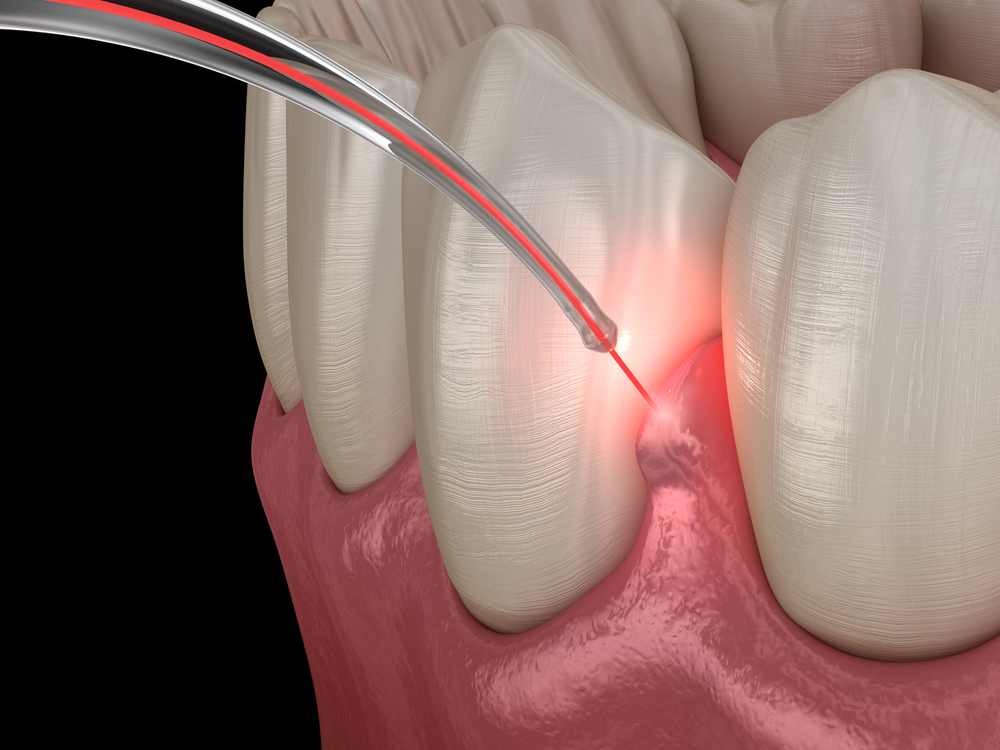
Beat gum disease. Don’t let gum disease beat you!
Gum Treatments
Our teeth are supported in the mouth by several structures such as the gum tissue and surrounding bone and ligaments. Gum disease or periodontal disease results in inflammation and breakdown of the gum tissue and, if left untreated, the surrounding bone.
Gum disease occurs due to local factors along with systemic influence and a poor immune response. It is a progressive disease caused due to the accumulation of bacteria-containing tartar, plaque and calculus over a period of time. The bacteria release toxins to the surrounding areas causing infection and tissue breakdown. The disease may be limited to localized areas or may even spread and become generalized.
Periodontal disease can cause problems such as gum recession, excess gum tissue, dental abscess, inflammation of the gums, and even loss of the tooth. Often times, patients experience symptoms such as a dull, throbbing pain in the gums, pus discharge, bleeding gums, persistent bad breath, mobile teeth, difficulty in chewing, food lodgement, etc.
How do I know if I have gum disease?
- Bleeding gums
- Gum inflammation causing red, swollen and painful gums.
- Mouth pain
- Pus drainage
- Foul taste in the mouth
- Bad breath
- Lowering of the gum level that makes teeth appear longer
- Loose teeth or loss of teeth
Our Periodontist will do a thorough evaluation of the gums, teeth, and surrounding bone along with a thorough medical history. The treatment will be tailored to your existing conditions. Treatment of gum disease involves the removal local factors such as bacterial deposits. This involves deep cleaning and advanced therapies done by our Periodontist or Gum Specialist.
Treatment of Gum disease
Non-Surgical Periodontal Therapy
Routine Dental Cleaning
Regular dental cleaning goes a long way in maintain gum health and preventing extensive gum disease. It involves the removal of any accumulated stains, tartar, plaque, and calculus and is the recommended line of treatment for mild gum disease.
We advise all our patients to undergo routine dental cleaning bi-annually. This also allows us to assess your oral health periodically so that early detection of dental illness is possible.
Deep Cleaning
In cases where the gum disease has started to advance and there is a considerable build-up of calculus and plaque which has gone below the level of the gum line, a deep cleaning is recommended in order to remove the source of infection.
Scaling and Root Planing
In moderate cases of gum disease, tissue breakdown and loss of surrounding bone occurs. The gums are fairly inflamed, there is chronic infectious tissue in the gum pocket, and the teeth may be loose. This is due to a significant build-up of calculus and plaque below the level of the gum line along with long standing infectious gum tissue. In order to remove this, the area has to be fully debrided and the surfaces are smoothened to reduce retention of periodontal deposits. The chronic infectious tissue is also removed. The treatment is generally done under local anaesthesia and may require 2-3 sittings.
Localized Drug Therapy
Periodontal infection in a localized area can be treated with target localized drug delivery in which medication is placed into the gum tissue to allow it to act directly on the bacteria causing infection
Laser Periodontal Therapy
Laser therapy for periodontal disease will be recommended for selective situations after an evaluation by the periodontist.
Surgical Therapy
When gum disease has reached an advanced and severe stage, the patient can present with major gum inflammation and infection, advanced loss of surrounding tissue and bone, few or many loose teeth and maybe even missing teeth. As the gum disease as advanced deeper into the tissue, in order to remove the periodontal deposits, surgical methods are used and a complete debridement is done.
Flap Surgery
In flap surgery, the gum tissue is elevated in order to access the underlying areas and the deposits and chronic infectious tissue are removed. The tissue is then placed back, sutured and allowed to heal. Following a flap surgery, the patient is advised to continue maintenance periodontal care.
Bone Grafting
Bone grafting is done in cases where the periodontal disease has resulted in a bone defect. Grafting material is used to fill the defect and is given time to heal and get incorporated into the surrounding areas over a period of time.
Soft Tissue Grafting
Receding gums or lowing of gum tissue can present many challenges for the patient such as:
- Longer tooth structure
- Sensitivity
- Increased chances of infection
- Difficulty in maintaining hygiene
- Loss of strong gum tissue and in turn strength of the teeth
- Poor aesthetic appearance.
In these cases, soft tissue grafting can be done to compensate for loss of gum tissue due to disease.